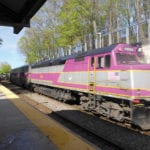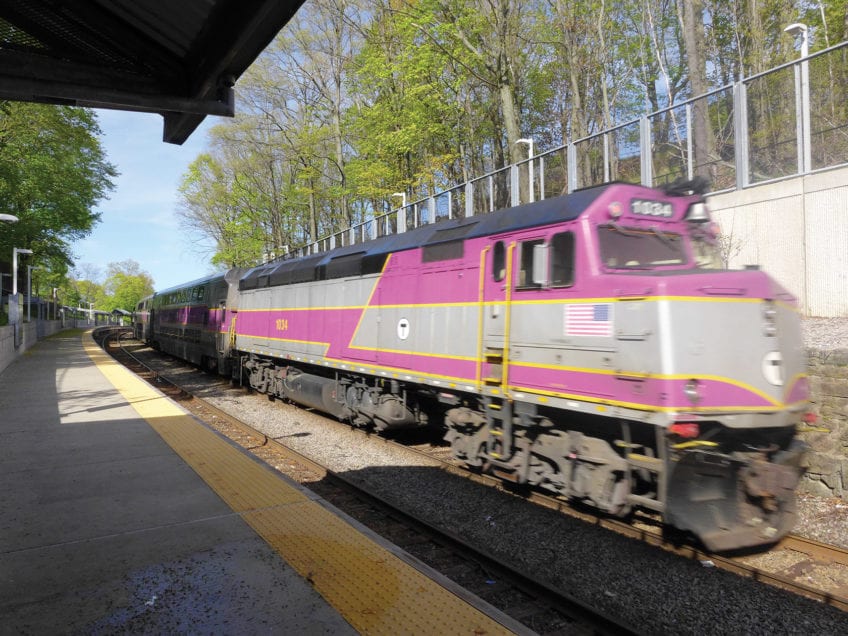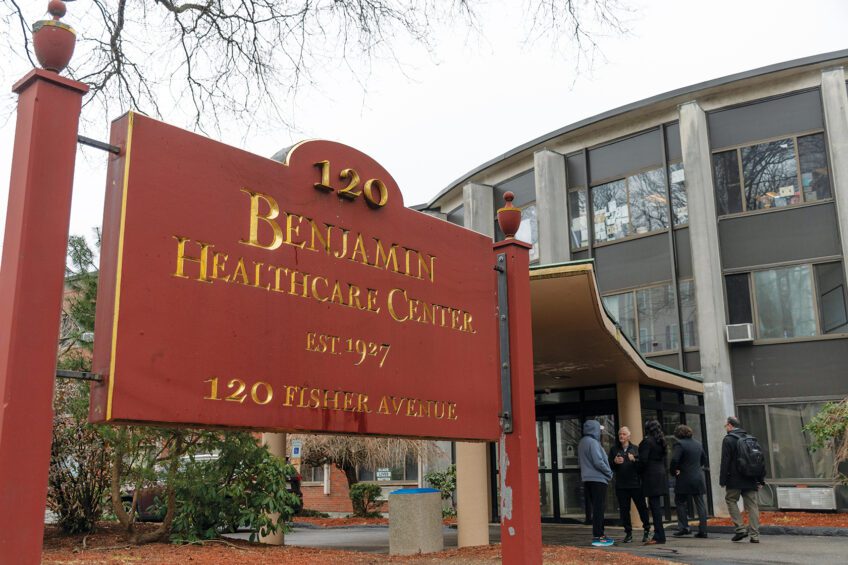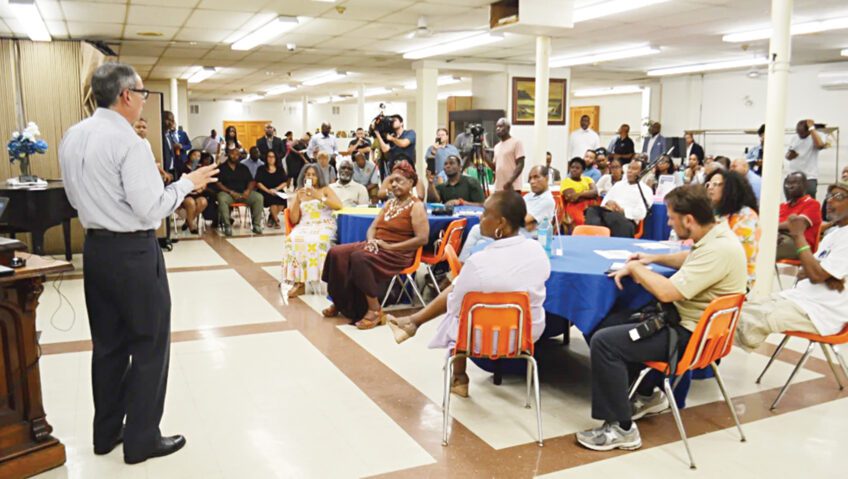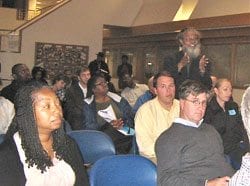
The Boston Transportation Department (BTD) held a public meeting Oct. 11 to discuss plans to improve Melnea Cass Boulevard, the busy lower Roxbury thoroughfare that cuts a curving path from Ruggles Station to Massachusetts Avenue.
The event was billed as a chance to discuss a “new vision” for a “safe and accessible, green and smart, pedestrian-friendly” corridor. Instead, it became a contentious session in which vocal audience members chided presenters for leaving out a decades-long history of planning and community input.
More than 80 people attended the meeting at Goodwill Industries, 1010 Harrison Ave. Among them were state Reps. Gloria Fox and Byron Rushing, whose districts each encompass portions of the Melnea Cass area; District 7 City Councilor Tito Jackson; and state Sen. Sonia Chang-Diaz, who arrived toward the end.
The BTD is the lead agency among a group of city and state agencies involved in the design project, to be funded by $600,000 in City of Boston funds and $7.5 million in federal earmarks and state funding. A team of consultants with expertise in transportation engineering, bicycle planning and landscape architecture has been engaged to help with the planning.
Vineet Gupta, BTD’s director of planning, introduced a proposed timeline. In what he called an “aggressive schedule,” the hope is to have an initial design concept by spring 2012 and a final bid-ready design by fall 2012.
Keri Pyke, director of transportation planning at Howard/Stein-Hudson Associates and the leader of the outside consultant team, gave a slide presentation about the project. She spoke of the “multi-modal” philosophy that will underlie any proposed plan.
“The design will need to serve all users. Not just pedestrians. Not just cars,” she said. She noted that Melnea Cass Boulevard is a major route for buses and delivery vehicles, and a new design needs to accommodate that, even while adding pedestrian- and bicycle-friendly features.
She showed images from other parts of Boston and from cities such as Cleveland and San Francisco as examples of different ways to integrate public transit and its riders with other traffic on busy streets. She also mentioned improved parking options and “green” methods of managing storm water.
But before the slide show was over, discontent was evident as listeners fired a barrage of questions and concerns.
“How can this process happen before we know what’s going to be developed?” asked Klare Allen, a longtime Roxbury community organizer. She was referring to vacant land parcels along Melnea Cass Boulevard, some of which have development proposals under review. “Aren’t we jumping the gun?”
Some others echoed this sentiment, saying brainstorming now would be working “in a vacuum.”
Some referred to the Urban Ring project, a state-led initiative to create cross-town links between transit routes in Greater Boston. They speculated it would be difficult to devise new goals without knowing Melnea Cass Boulevard’s place in that project. Others wondered if the planners had considered the Roxbury Strategic Master Plan, a framework for future development devised in the 1990s and 2000s by the BRA and local community members.
Both Fox and Rushing expressed strong dissatisfaction with the lack of attention given to the decisions made by committees and in public meetings over the past several decades.
“Maybe the planners need to know they’re in a room full of historians,” said Fox.
“I am very disturbed,” Rushing said, “that we are not being told that the planners understand all the work we’ve already done. You have people in this room who have sat through all of these meetings. We’re told it’s important — but it’s not important if it’s not remembered.”
Rushing elaborated in an e-mail that the history missing from the presentation included not only the Roxbury Master Plan and Urban Ring, but Boston Parks Department plans for the area and requirements contained in the requests for proposals for parcels 9 and 10 near Washington Street.
At the meeting, Councilor Jackson attempted to sum up the frustration in the room. “What I’m hearing is that you need to give honor and respect to what’s already been done,” he told the presenters. “It can’t be that people come from the outside and say what’s going to be done.” He urged the planners not to move too fast, as “this is a really, really important process.”
Gupta, put on the defensive, stressed that this was the very first meeting for the project; there is much public input and planning to come. “The goals will come from you,” he said.
As for whether they were “jumping the gun,” he disagreed.
“In many ways the timing is good, because we’ll be working simultaneously with the developers and the designs of those parcels,” he said. “It’s a two-way process. This is what we want to see on Melnea Cass — can the development proposals respond to that?”
The plan for the evening had been to follow the brief presentation with small-group brainstorming on three questions: What do you think currently works well on Melnea Cass Boulevard? What do you think works poorly? What does your vision of success on Melnea Cass Boulevard look like?
But in the face of increasing heat, the consultants discontinued the slide show to respond to questions. When it became clear that the most vocal audience members were decidedly against starting the brainstorming, Gupta scrapped the breakout sessions and adjourned the meeting early.
In advance of the next meeting, he promised, the team would compile a set of documents to address the questions about historical decisions and related projects.
Afterward, some filed silently out. Those who lingered did not seem to consider the meeting a failure.
Donovan Walker, a member of the Roxbury Strategic Master Plan Oversight Committee, saw a victory in forcing the planners to come back with documents.
“Not having the breakout groups tonight stopped what they could do,” he said. “There’s a lot happening out there, that the community does not recognize is happening — and if you’re not aware, it’s putting the cart before the horse.”
BTD Senior Transportation Planner Patrick Hoey said he was not disappointed in the meeting.
“I’m glad we had such a good turnout,” he said. “We really want to hear from the community.”
In a later e-mail, Hoey said the team had certainly taken earlier planning efforts into account. “As far as the Urban Ring is concerned, it is very relevant and was called out specifically in our Requests for Proposals for this project,” he wrote. “The same goes for the Roxbury Strategic Master Plan, which echoes the desire to see transit emphasized along a ‘Crosstown Corridor.’ The two are essentially the foundation for design of Melnea Cass Boulevard”
Information about the Melnea Cass Boulevard design project, including slides from the Oct. 11 meeting, will be posted on the BTD’s Complete Streets website, http://bostoncompletestreets.org.

